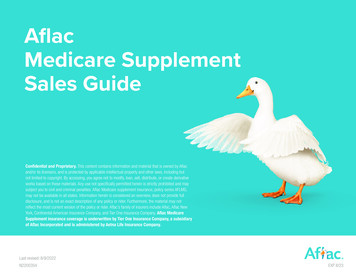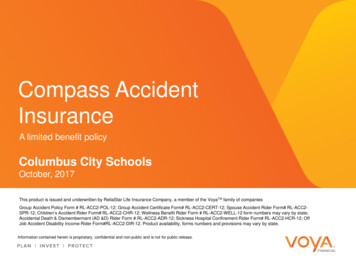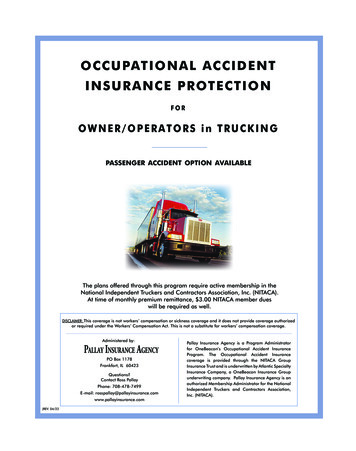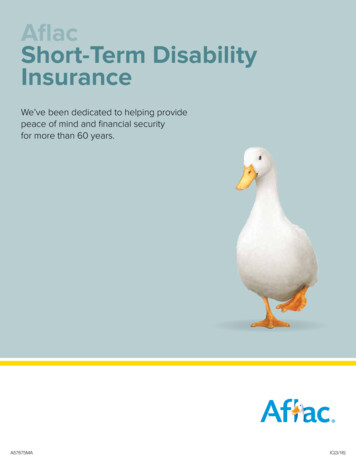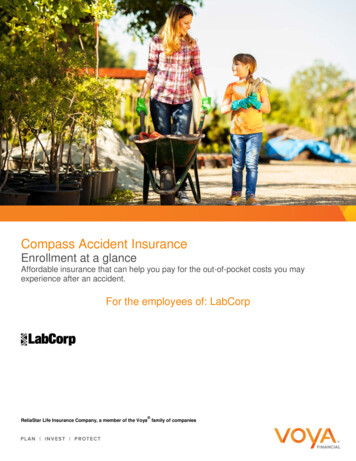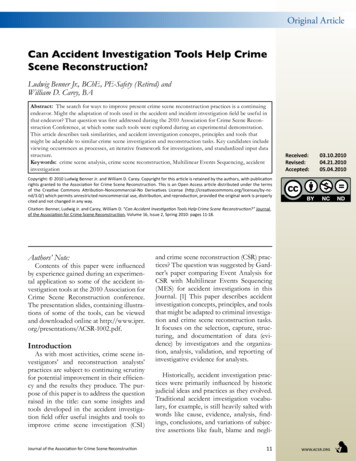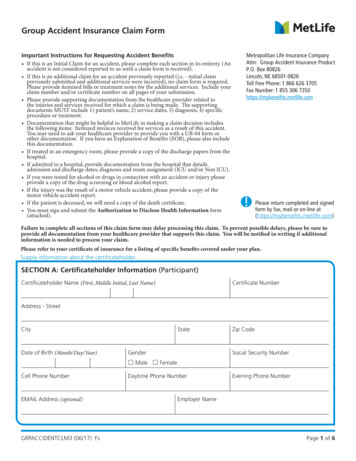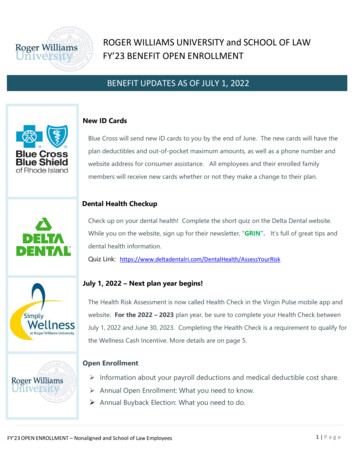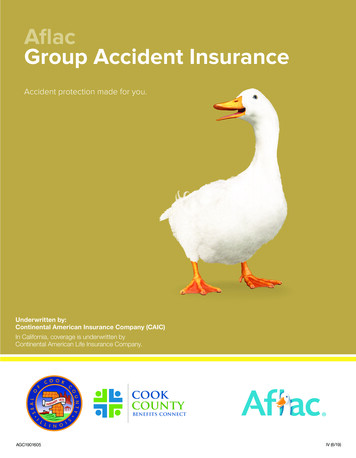
Transcription
AflacGroup Accident InsuranceAccident protection made for you.Underwritten by:Continental American Insurance Company (CAIC)In California, coverage is underwritten byContinental American Life Insurance Company.AGC1901605IV (6/19)
AFLAC GROUP ACCIDENT INSURANCE Policy Series C70000Just because an accident can change yourhealth, doesn’t mean it should change yourlifestyle too.Accidents can happen in an instant affecting you or a loved one. Aflac is designed to help families plan for thehealth care bumps ahead and take some of the uncertainty and financial insecurity out of getting better.Protection for the unexpected, that’s the benefit of the Aflac Group Accident Plan.After an accident, you may have expenses you’ve never thought about. Can your finances handle them? It’sreassuring to know that an accident insurance plan can be there for you in your time of need to help coverexpenses such as: Ambulance rides Prescriptions Emergency room visits Major Diagnostic Testing Surgery and anesthesia BurnsPlan Features Benefits are paid directly to you, unless otherwise assigned. Coverage is guaranteed-issue (which means you may qualify for coverage without having to answerhealth questions). Benefits are paid regardless of any other medical insurance.What you need, when you need it.Group accident insurance pays cashbenefits that you can use any wayyou see fit.For more information, call 1-800-698-2849, or visitCookCountyVoluntaryBenefits.com.
GROUP ACCIDENT INSURANCEHIGHLOWINI T I A L T R E AT M E N T (once per accident, within 7 days after the accident, not payable for telemedicine services) Payable when an insuredreceives initial treatment for a covered accidental injury. This benefit is payable for initial treatment received under the care of adoctor when an insured visits the following:Hospital emergency room with X-Ray / without X-Ray 250/ 200 150/ 100Urgent care facility with X-Ray / without X-Ray 250/ 200 150/ 100Doctor’s office or facility (other than a hospital emergency room or urgent care) with X-Ray / without X-Ray 150/ 100 100/ 50A M BU L A N CE (within 90 days after the accident) Payable when an insured receives transportation by aprofessional ambulance service due to a covered accidental injury. 400Ground 1,200 Air 200Ground 800 Air 200 100 100Each 24hour period 50Each 24hour period 50Less than24 hours,but at least4 hours 25Less than24 hours,but at least4 hoursP R E S CRIP T IO N S (2 times per accident, within 6 months after the accident) Payable for a prescription filledthat - due to a covered accidental injury - is ordered by a doctor, dispensed by a licensed pharmacistand medically necessary for the care and treatment of the insured (in Alaska, Massachusettsand Montana prescriptions do not have to be medically necessary). This benefit is not payablefor therapeutic devices or appliances; experimental drugs; drugs, medicines or insulin used byor administered to a person while he is confined to a hospital, rest home, extended-care facility,convalescent home, nursing home or similar institution; or immunization agents, biological sera, bloodor blood plasma. This benefit is not payable for pain management techniques for which a benefit ispaid under the Pain Management Benefit (if available). 5 5BL O OD/ P L A SM A / P L AT E L E T S (3 times per accident, within 6 months after the accident) Payable for each daythat an insured receives blood, plasma or platelets due to a covered accidental injury. 200 100PA IN M A N AG EM E N T (once per accident, within 6 months after the accident) Payable when an insured, dueto a covered accidental injury, is prescribed and receives a nerve ablation and/or block, or an epiduralinjection administered into the spine. This benefit is only payable for pain management techniques (asshown above) that are administered in a hospital or doctor’s office. This benefit is not payable for anepidural administered during a surgical procedure. 100 50C O N C U S SIO N (once per accident, within 6 months after the accident) Payable when an insured is diagnosedby a doctor with a concussion due to a covered accident. 500 200 5,000 2,500M A J O R DI AG N O S T IC T E S T ING (once per accident, within 6 months after the accident) Payable when aninsured requires one of the following exams: Computerized Tomography (CT/CAT scan), MagneticResonance Imaging (MRI), or Electroencephalography (EEG) due to a covered accidental injury. Theseexams must be performed in a hospital, a doctor’s office, a medical diagnostic imaging center or anambulatory surgical center.EM E RG E N CY RO O M O B S E RVAT IO N (within 7 days after the accident) Payable when an insured receivestreatment in a hospital emergency room, and is held in a hospital for observation without beingadmitted as an inpatient because of a covered accidental injury.T R AU M AT IC BR A IN IN J U RY (once per accident, within 6 months after the accident) Payable when aninsured is diagnosed by a neurologist with Traumatic Brain Injury (TBI) due to a covered accident. Toqualify as TBI, the neurological deficit must require treatment by a neurologist and a prescribed courseof physical, speech and/or occupational therapy under the direction of a neurologist.
EMERGENCY DENTAL WORK (once per accident, within 6 months after the accident) Payable when an insured’snatural teeth are injured as a result of a covered accident. 50Extraction 25Extraction 200Repair with acrown 75Repair witha crownBU R N S (once per accident, within 6 months after the accident) Payable when an insured is burned in a covered accident andis treated by a doctor. We will pay according to the percentage of body surface burned. First degree burns are notcovered.Second DegreeLess than 10% 100 50At least 10% but less than 25% 200 100At least 25% but less than 35% 500 250 1,000 500Less than 10% 1,000 500At least 10% but less than 25% 5,000 2,500At least 25% but less than 35% 10,000 5,00035% or more 20,000 10,000E Y E IN J U RIE S Payable for eye injuries if, because of a covered accident, a doctor removes a foreignbody from the eye, with or without anesthesia. 250 100F R AC T U R E S (once per accident, within 90 days after the accident) Payable when an insured fractures a bonebecause of a covered accident and is treated by a doctor. If the fracture requires open reduction,200% of the benefit is payable for that bone. For multiple fractures (more than one bone fracturedin one accident), we will pay a maximum of 200% of the benefit amount for the bone fractured thathas the highest dollar amount. For a chip fracture (a piece of bone that is completely broken off neara joint), we will pay 25% of the amount for the affected bone. This benefit is not payable for stressfractures.Up to 4,000based on ascheduleUp to 2,500based on ascheduleDIS L O CAT IO N S (once per accident, within 90 days after the accident) Payable when an insured dislocatesa joint because of a covered accident and is treated by a doctor. If the dislocation requires openreduction, 200% of the benefit for that joint is payable. We will pay benefits only for the first dislocationof a joint. We will not pay for recurring dislocations of the same joint. If the insured dislocated a jointbefore the effective date of his certificate and then dislocates the same joint again, it will not be coveredby the plan. For multiple dislocations (more than one dislocated joint in one accident), we will pay amaximum of 200% of the benefit amount for the joint dislocated that has the highest dollar amount.For a partial dislocation (joint is not completely separated, including subluxation), we will pay 25% of theamount for the affected joint.Up to 3,000based on ascheduleUp to 1,500based on aschedule35% or moreThird DegreeL ACE R AT IO N S (once per accident, within 7 days after the accident) Payable when an insured receives a laceration in acovered accident and the laceration is repaired by a doctor. For multiple lacerations, we will pay a maximum of 200%of the benefit for the largest single laceration requiring stitches. Lacerations requiring stitches (including liquid skinadhesive):Over 15 centimeters 500 1005-15 centimeters 300 60Under 5 centimeters 75 40Lacerations not requiring stitches 35 25O U T PAT IE N T S U RG E RY A ND A N E S T H E SI A (per day / performed in hospital or ambulatory surgical center,within one year after the accident) Payable for each day that, due to a covered accidental injury, an insuredhas an outpatient surgical procedure performed by a doctor in a hospital or ambulatory surgical center.Surgical procedure does not include laceration repair. If an outpatient surgical procedure is coveredunder another benefit in the plan, we will pay the higher benefit amount. 400 200
FACIL I T IE S F E E F O R O U T PAT IE N T S U RG E RY (surgery performed in hospital or ambulatory surgical center,within one year after the accident) Payable once per each eligible Outpatient Surgery and AnesthesiaBenefit (in a hospital or ambulatory surgical center). 100 35O U T PAT IE N T S U RG E RY A ND A N E S T H E SI A (per day / performed in a doctor’s office, urgent care facility, oremergency room; maximum of two procedures per accident, within one year of the accident)Payable for each day that, due to a covered accidental injury, an insured has an outpatient surgicalprocedure performed by a doctor in a doctor’s office, urgent care facility or emergency room. Surgicalprocedure does not include laceration repair. If an outpatient surgical procedure is covered underanother benefit in this plan, we will pay the higher benefit amount. 50 25IN PAT IE N T S U RG E RY A ND A N E S T H E SI A (per day / within one year after the accident) Payable for eachday that, due to a covered accidental injury, an insured has an inpatient surgical procedure performedby a doctor. The surgery must be performed while the insured is confined to a hospital as an inpatient.If an inpatient surgical procedure is covered under another benefit in the plan, we will pay the higherbenefit amount. 1,000 500S U C CE S S O R IN S U R ED BE N E F I TIf spouse coverage is in force at the time of the employee’s death, the surviving spouse may elect to continue coverage. Coveragewould continue according to the existing plan and would also include any dependent child coverage in force at the time.Surgical Procedures may include, but are not limited to, surgical repair of: ruptured disc, tendons/ligaments, hernia, rotator cuff, tornknee cartilage, skin grafts, joint replacement, internal injuries requiring open abdominal or thoracic surgery, exploratory surgery (with orwithout repair), etc., unless otherwise noted due to an accidental injury.AFTER CARE BENEFITSHIGHLOWCane, Ankle Brace 50 25Walking Boot, Walker, Crutches, Leg Brace, Cervical Collar 200 75Wheelchair, Knee Scooter, Body Jacket, Back Brace 300 150AC CIDE N T F O L L OW-U P T R E AT M E N T (maximum of 2 per accident, within 6 months after the accident providedinitial treatment is within 7 days of the accident)Payable for doctor-prescribed follow-up treatment for injuries received in a covered accident.Follow-up treatments do not include physical, occupational or speech therapy. Chiropractic oracupuncture procedures are also not considered follow-up treatment. 100 50P O S T-T R AU M AT IC S T R E S S DIS O RDE R ( P T SD) (once per accident, within 6 months after the accident)Payable if the insured is diagnosed with PTSD, a mental health condition triggered by a coveredaccident. An insured must meet the diagnostic criteria for PTSD, stipulated in the Diagnostic andStatistical Manual of Mental Disorders IV (DSM IV-TR), and be under the active care of either apsychiatrist or Ph.D.-level psychologist. 200 50 50per day 35per dayA P P L I A N CE S (within 6 months after the accident)Payable if, as a result of an injury received in a covered accident, a doctor advises the insured to use alisted medical appliance as an aid in personal locomotion.R E H A BIL I TAT IO N U NI T (maximum of 31 days per confinement, no more than 62 days total per calendar year foreach insured)Payable for each day that, due to a covered accidental injury, an insured receives treatment as aninpatient at a rehabilitation facility. For this benefit to be payable, the insured must be transferred to therehabilitation facility for treatment following an inpatient hospital confinement.We will not pay the rehabilitation facility benefit for the same days that the hospital confinement benefit ispaid. We will pay the highest eligible benefit.
T H E R A PY (maximum of 10 per accident, beginning within 90 days after the accident provided initial treatment is within 7 daysafter the accident)Payable if because of injuries received in a covered accident, an insured has doctor-prescribed therapytreatment in one of the following categories: physical therapy provided by a licensed physical therapist,occupational therapy provided by a licensed occupational therapist, or speech therapy provided by alicensed speech therapist. 40 20CHIRO P R AC T IC O R A LT E R N AT I V E T H E R A PY (maximum of 6 per accident, beginning within 90 days after theaccident provided initial treatment is within 7 days after the accident)Payable if because of injuries received in a covered accident, an insured receives acupuncture orchiropractic treatment. 30 15HOSPITALIZATION BENEFITSHIGHLOWH O S PI TA L A DMIS SIO N (once per accident, within 6 months after the accident)Payable when an insured is admitted to a hospital and confined as an inpatient because of a coveredaccidental injury.This benefit is not payable for confinement to an observation unit, for emergency room treatment or foroutpatient treatment. 2,000 1,000perperconfinement confinementH O S PI TA L C O N F IN EM E N T (maximum of 365 days per accident, within 6 months after the accident)Payable for each day that an insured is confined to a hospital as an inpatient because of a coveredaccidental injury.If we pay benefits for confinement and the insured is confined again within 6 months because of thesame accidental injury, we will treat this confinement as the same period of confinement.This benefit is payable for only one hospital confinement at a time even if caused by more than onecovered accidental injury. This benefit is not payable for confinement to an observation unit or arehabilitation facility. 200per day 100per dayH O S PI TA L IN T E N SI V E CA R E (maximum of 30 days per accident, within 6 months after the accident)Payable for each day an insured is confined in a hospital intensive care unit because of a coveredaccidental injury.We will pay benefits for only one confinement in a hospital intensive care unit at a time, even if it is causedby more than one covered accidental injury.If we pay benefits for confinement in a hospital intensive care unit and an insured becomes confined to ahospital intensive care unit again within 6 months because of the same accidental injury, we will treat thisconfinement as the same period of confinement.This benefit is payable in addition to the Hospital Confinement Benefit. 200per day 100per dayIN T E RM EDI AT E IN T E N SI V E CA R E S T E P-DOW N U NI T (maximum of 30 days per accident, within 6 monthsafter the accident)Payable for each day an insured is confined in an intermediate intensive care step-down unit because ofa covered accidental injury.We will pay benefits for only one confinement in an intermediate intensive care step-down unit at a time,even if it is caused by more than one covered accidental injury.If we pay benefits for confinement in an intermediate intensive care step-down unit and an insuredbecomes confined to an intermediate intensive care step-down unit again within 6 months because ofthe same condition, we will treat this confinement as the same period of confinement.This benefit is payable in addition to the Hospital Confinement Benefit. 100per day 50per dayFA MILY M EM BE R L ODGING (greater than 100 miles from the insured’s residence, maximum of 30 days peraccident, within 6 months after the accident)Payable for each night’s lodging in a motel/hotel/rental property for an adult member of the insured’simmediate family. For this benefit to be payable: The insured must be confined to a hospital for treatment of a covered accidental injury; The hospital and motel/hotel must be more than 100 miles from the insured’s residence; and The treatment must be prescribed by the insured’s treating doctor. 100per day 50per day
LIFE CHANGING EVENTS BENEFITSHIGHLOWPA R A LYSIS (once per accident, diagnosed by a doctor within six months after the accident)Payable if an insured has permanent loss of movement of two or more limbs for more than 90 days (inUtah, 30 days) as the result of a covered accidental injury.Paraplegia 4,000 2,500Quadriplegia 8,000 5,000 2,000 1,000 1,000 500P RO S T H E SIS (once per accident, up to 2 prosthetic devices and one replacement per device per insured)*Payable when an insured receives a prosthetic device, prescribed by a doctor, as a result of a coveredaccidental injury.Prosthetic Device/Prosthesis means an artificial device designed to replace a missing part of thebody. This benefit is not payable for hearing aids, wigs, or dental aids (to include false teeth), repair orreplacement of prosthetic devices* and /or joint replacements.* We will pay this benefit again once to cover the replacement of a prosthesis for which a benefit hasbeen paid, provided the replacement takes place within three years of the initial benefit payment.R E SIDE N CE / V E HICL E M ODIF ICAT IO N (once per accident, within one year after the accident)Payable for a permanent structural modification to an insured’s primary residence or vehicle whenthe insured suffers total and permanent or irrevocable loss of one of the following, due to a coveredaccidental injury: The sight of one eye; The use of one hand/arm; or The use of one foot/leg.WAIVER OF PREMIUM RIDERIf the employee becomes totally disabled due to a covered sickness* or accidental injury, after 90 days of total disability, we will waivepremiums for the employee and any covered dependents. As long as the employee remains totally disabled, premium will be waivedup to 24 months, subject to the terms of the plan.*In New Hampshire, Tennessee, and Texas, not applicable.
INITIAL ACCIDENT EXCLUSIONSEXCLUSIONSPlan exclusions apply to all riders unless otherwise noted.We will not pay benefits for accidental injury, disability or death contributed to,caused by, or resulting from*: War – voluntarily participating in war, any act of war, or military conflicts,declared or undeclared, or voluntarily participating or serving in the military,armed forces or an auxiliary unit thereto, or contracting with any country orinternational authority. (We will return the prorated premium for any periodnot covered by the certificate when the insured is in such service.) War alsoincludes voluntary participation in an insurrection, riot, civil commotion or civilstate of belligerence. War does not include acts of terrorism. In California: voluntarily participating in war, any act of war, or militaryconflicts, declared or undeclared, or voluntarily participating or serving inthe military, armed forces, or an auxiliary unit thereto or contracting withany country or international authority. (We will return the prorated premiumfor any period not covered by the certificate when the insured is in suchservice.) War also includes voluntary participation in an insurrection or riot. In Idaho: participating in any war or act of war, declared or undeclared, orparticipating or serving in the armed forces or units auxiliary thereto. Waralso includes participation in a riot or an insurrection. In Illinois: the statement “war does not include acts of terrorism” is deleted. In Michigan: voluntarily participating in war or any act of war. War alsoincludes voluntary felonious participation in an insurrection, riot, civilcommotion or civil state of belligerence. War does not include acts ofterrorism. In North Carolina: War – voluntarily participating in war, any act of war,or military conflicts, declared or undeclared, or voluntarily participatingor serving in the military, armed forces or an auxiliary unit thereto, orcontracting with any country or international authority. (We will return theprorated premium for any period not covered by the certificate when theinsured is in such service.) War also includes civil participation in an activeriot. War does not include acts of terrorism. Suicide – committing or attempting to commit suicide, while sane or insane. In Montana: committing or attempting to commit suicide, while sane In Illinois, Michigan and Minnesota: this exclusion does not apply Sickness – having any disease or bodily/mental illness or degenerative process.We also will not pay benefits for: Allergic reactions Any bacterial, viral, or microorganism infection or infestation or anycondition resulting from insect, arachnid or other arthropod bites or stings.In Illinois: any bacterial infection, except an infection which results from anaccidental injury or an infection which results from accidental, involuntaryor unintentional ingestion of a contaminated substance; any viral ormicroorganism infection or infestation; or any condition resulting frominsect, arachnid or other arthropod bites or stings. In North Carolina: anyviral or microorganism infestation or any condition resulting from insect,arachnid or other arthropod bites or stings An error, mishap or malpractice during medical, diagnostic, or surgicaltreatment or procedure for any sickness Any related medical/surgical treatment or diagnostic procedures for suchillness Self-Inflicted Injuries – injuring or attempting to injure oneself intentionally. In Idaho: intentionally self-inflicting injury. In Montana: injuring or attempting to injure oneself intentionally,while sane In Michigan: this exclusion does not apply Racing – riding in or driving any motor-driven vehicle in a race, stunt show orspeed test in a professional or semi-professional capacity. In Idaho: this exclusion does not apply Illegal Occupation – voluntarily participating in, committing or attemptingto commit a felony or illegal act or activity, or voluntarily working at or beingengaged in, an illegal occupation or job. In California, Nebraska and Tennessee: voluntarily participating in,committing, or attempting to commit a felony; or voluntarily working at, orbeing engaged in, an illegal occupation or job. In Illinois and Pennsylvania: committing or attempting to commit a felony orbeing engaged in an illegal occupation In Michigan: voluntarily participating in, committing or attempting to commita felony, or being engaged in an illegal occupation In Idaho and South Dakota: this exclusion does not apply Sports – participating in any organized sport in a professional or semiprofessional capacity for pay or profit. In California and Idaho: participating in any organized sport in a professionalcapacity for pay or profit Cosmetic Surgery – having cosmetic surgery or other elective procedures thatare not medically necessary or having dental treatment except as a result of acovered accident. In Alaska, Massachusetts and Montana: having cosmetic surgery, otherelective procedures or dental treatment except as a result of a coveredaccident. In California: having cosmetic surgery or other elective proceduresthat are not medically necessary (“cosmetic surgery” does not includereconstructive surgery when the service is related to or follows surgeryresulting from a covered accident); or having dental treatment except as aresult of a covered accident. In Idaho: having cosmetic surgery or other elective procedures that arenot medically necessary or having dental treatment except as a result of acovered accident. Cosmetic surgery shall not include reconstructive surgerybecause of a Congenital Anomaly of a covered dependent child. Felony (In Idaho only) – participation in a felonyFor 24-Hour Coverage, the following exclusions will not apply:An injury arising from any employment.An injury or sickness covered by worker’s compensation.In North Carolina: services or supplies for the treatment of an occupationalinjury or sickness which are paid under the North Carolina workers’compensation act only to the extent such services or supplies are the liability ofthe employee, employer, or workers’ compensation insurance carrier accordingto a final adjudication under the North Carolina Workers’ Compensation Act oran order of the North Carolina Industrial Commission approving a settlementagreement under the North Carolina Workers’ Compensation Act.*“Contributed to” language doesn’t apply in IllinoisDEFINITIONSNote: In New Hampshire, all mentions of “Treatment” refer to “Care”.Accidental Injury means accidental bodily damage to an insured resultingfrom an unforeseen and unexpected traumatic event. This must be the directresult of an accident and not the result of disease or bodily infirmity. A CoveredAccidental Injury is an accidental injury that occurs while coverage is inforce. A Covered Accident is an accident that occurs on or after an insured’seffective date while coverage is in force, and that is not specifically excluded bythe plan.Ambulatory Surgical Center is defined as a licensed surgical centerconsisting of an operating room; facilities for the administration of generalanesthesia; and a post-surgery recovery room in which the patient is admittedand discharged within a period of less than 24 hours.Dependent Child or Dependent Children means your or your spouse’snatural children, step-children, grandchildren who are in your legal custody andresiding with you, foster children, children subject to legal guardianship, legallyadopted children, or children placed for adoption, who are younger than age 26(and in Louisiana, unmarried). Newborn children may be automatically coveredfrom the moment of birth for 60 days. Newly adopted children (and fosterchildren in North Carolina and Florida) may also be automatically covered for 60days. See certificate for details.
Doctor is a person who is duly qualified as a practitioner of the healing artsacting within the scope of his license, and is licensed to practice medicine;prescribe and administer drugs; or to perform surgery, or is a duly qualifiedmedical practitioner according to the laws and regulations in the state in whichtreatment is made.In Montana, for purposes of treatment, the insured has full freedom ofchoice in the selection of any licensed physician, physician assistant, dentist,osteopath, chiropractor, optometrist, podiatrist, psychologist, licensed socialworker, licensed professional counselor, acupuncturist, naturopathic physician,physical therapist, speech-language pathologist, audiologist, licensed addictioncounselor, or advanced practice registered nurse.A Doctor does not include the insured or an insured’s family member. In SouthDakota however, a doctor who is an employee’s family member may treat theinsured if that doctor is the only doctor in the area and acts within the scopeof his practice. For the purposes of this definition, family member includesthe employee’s spouse as well as the following members of the employee’simmediate family son, daughter, mother, father, sister, and brother. This includesstep-family members and family-members-in-law.The term Hospital specifically excludes any facility not meeting the definition ofhospital as defined in this plan, including but not limited to: A nursing home, A rehabilitation facility, An extended-care facility, A facility for the treatment of A skilled nursing facility,alcoholism or drug addiction, or A rest home or home for the aged, An assisted living facility.Spouse is your legal wife, husband, or partner in a legally recognized union.Refer to your certificate for details.Telemedicine Service means a medical inquiry with a doctor via audio orvideo communication that assists with a patient’s assessment, diagnosis, andconsultation.Treatment is the consultation, care, or services provided by a doctor. Thisincludes receiving any diagnostic measures and taking prescribed drugs andmedicines. Treatment does not include telemedicine services.Urgent Care is a walk-in clinic that delivers ambulatory, outpatient care in adedicated medical facility for illnesses or injuries that require immediate carebut that are not serious enough to require a visit to an emergency room.HOSPITALIZATION BENEFITSHospital Intensive Care Unit means a place that meets all of the followingcriteria: Is a specifically designated area ofused for patient confinement;the hospital called a hospital intensive Is permanently equipped with specialcare unit;life-saving equipment for the care of Provides the highest level of medicalthe critically ill or injured;care; Is under close observation by aspecially trained nursing staff Is restricted to patients who areassigned exclusively to the hospitalcritically ill or injured and who requireintensive care unit 24 hours a day;intensive comprehensive observationand care;and Is separate and apart from the Has a doctor assigned to the hospitalsurgical recovery room and fromintensive care unit on a full-timerooms, beds and wards customarilybasis.The term Hospital Intensive Care Unit specifically excludes any type of facilitynot meeting the definition of hospital intensive care unit as defined in this plan,including but not limited to private monitored rooms, surgical recovery rooms,observation units and the following step-down units: A progressive care unit; A sub-acute intensive care unit; or An intermediate care unit.Intermediate Intensive Care Step-Down Unit means any of the following: A progressive care unit; A sub-acute intensive care unit; An intermediate care unit; or A pre- or post-intensive car
Group Accident Insurance Accident protection made for you. AGC1901605 IV (6/19) . speech and/or occupational therapy under the direction of a neurologist. 5,000 2,500 . maximum of two procedures per accident, within one year of the accident) Payable for each day that, due to a covered accidental injury, an insured has an outpatient .
